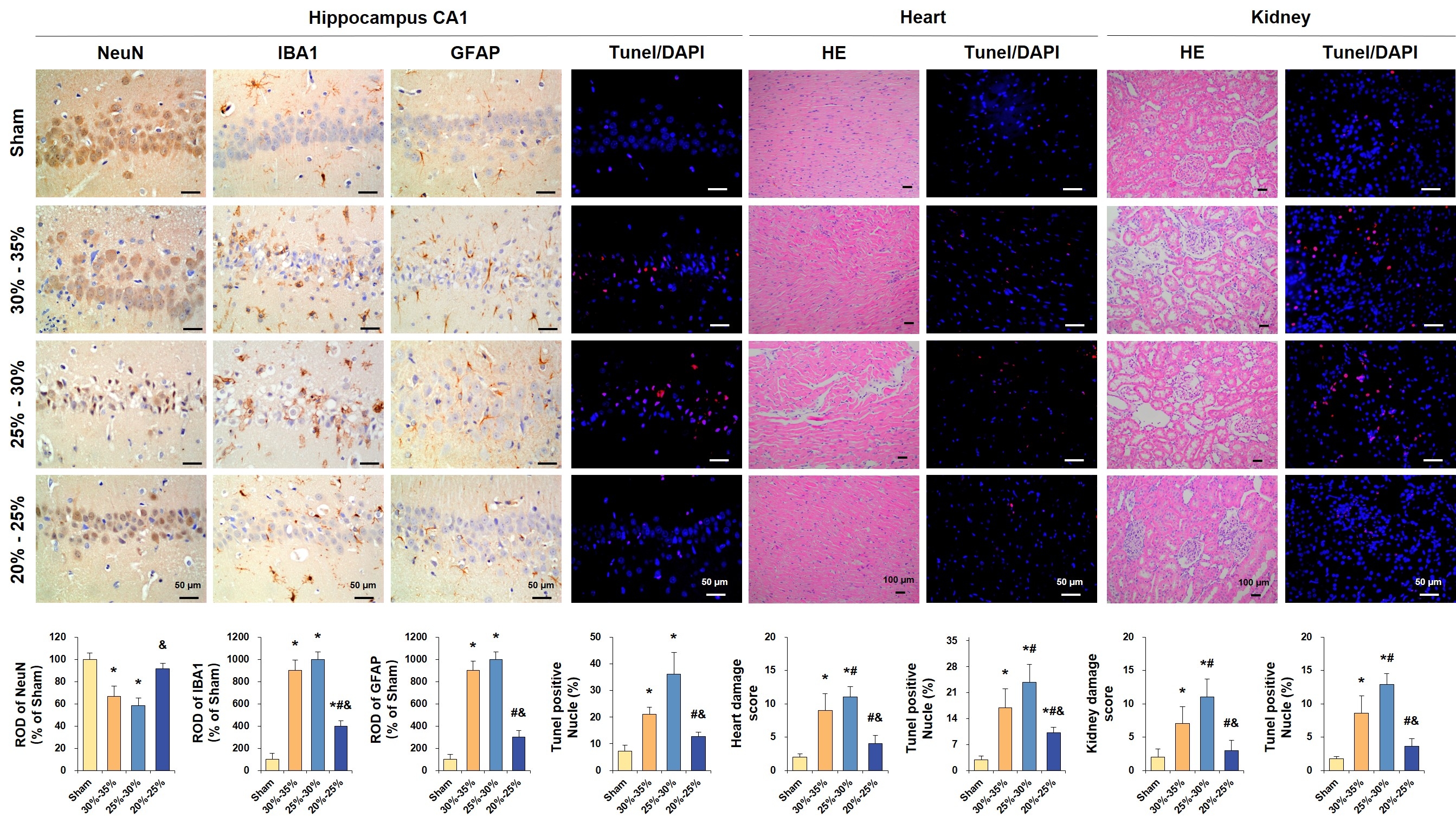Final ID: Sa209
Protective effects of hemodilution in emergency cardiopulmonary bypass resuscitation after cardiac arrest
Abstract Body:
Introduction: The no-reflow phenomenon is considered to be one of the important mechanisms of ischemia-reperfusion injury. Low hematocrit (Hct) after hemodilution can increase microcirculation flow by reducing blood viscosity and improve the non-reflow phenomenon after cardiac arrest. However, the effect of hemodilution remains controversial.
Hypothesis: To investigate the protective effect of hemodilution and the optimal Hct in emergency cardiopulmonary bypass (ECPB) resuscitation after cardiac arrest.
Methods: Male SD rats, 400-450 g were subjected to 8 min asphyxial CA and followed by ECPB resuscitation. Sham, Hct 30%-35%, Hct 25%-30% and Hct 20%-25% groups were included. Survival and Neurologic Deficit Score (NDS) were assessed at 24 h, 48 h and 72 h after return of spontaneous circulation (ROSC). Immunohistochemical staining for NeuN, IBA1, GFAP and Tunel staining were performed to assess neurological outcomes. HE staining and Tunel staining were performed to assess the outcomes of heart and kidney.
Results: There was no significant difference in survival among all groups. NDS in Hct 20%-25% group was significantly better than that in the Hct 30%-35% and Hct 25%-30% groups at 24 h after ROSC (P<0.05). Hippocampus was less injured in the Hct 20%-25% than in the Hct 30%-35% and Hct 25%-30% groups (Figure). Hct 20%-25% significantly attenuated damage to heart and kidney.
Conclusions: Hemodilution to Hct 20%-25% has a protective effect on the hippocampus, heart and kidney in ECPB resuscitation after cardiac arrest.
Introduction: The no-reflow phenomenon is considered to be one of the important mechanisms of ischemia-reperfusion injury. Low hematocrit (Hct) after hemodilution can increase microcirculation flow by reducing blood viscosity and improve the non-reflow phenomenon after cardiac arrest. However, the effect of hemodilution remains controversial.
Hypothesis: To investigate the protective effect of hemodilution and the optimal Hct in emergency cardiopulmonary bypass (ECPB) resuscitation after cardiac arrest.
Methods: Male SD rats, 400-450 g were subjected to 8 min asphyxial CA and followed by ECPB resuscitation. Sham, Hct 30%-35%, Hct 25%-30% and Hct 20%-25% groups were included. Survival and Neurologic Deficit Score (NDS) were assessed at 24 h, 48 h and 72 h after return of spontaneous circulation (ROSC). Immunohistochemical staining for NeuN, IBA1, GFAP and Tunel staining were performed to assess neurological outcomes. HE staining and Tunel staining were performed to assess the outcomes of heart and kidney.
Results: There was no significant difference in survival among all groups. NDS in Hct 20%-25% group was significantly better than that in the Hct 30%-35% and Hct 25%-30% groups at 24 h after ROSC (P<0.05). Hippocampus was less injured in the Hct 20%-25% than in the Hct 30%-35% and Hct 25%-30% groups (Figure). Hct 20%-25% significantly attenuated damage to heart and kidney.
Conclusions: Hemodilution to Hct 20%-25% has a protective effect on the hippocampus, heart and kidney in ECPB resuscitation after cardiac arrest.
More abstracts on this topic:
Efficacy of Restrictive versus Liberal Oxygenation in Patients undergoing Coronary Artery Bypass Grafting or Aortic Valve Replacement – a randomized clinical trial
Wiberg Sebastian, Boesgaard Soeren, Hassager Christian, Kober Lars, Nilsson Jens Christian, Moeller Christian Holdflod, Kjaergaard Jesper, Mikkelsen Astrid, Møller-sørensen Peter Hasse, Olsen Peter Skov, Høfsten Dan, Ravn Jesper, Ravn Hanne Berg
Agreement of Refractory Ventricular Fibrillation Subtyping Methods in Out-of-Hospital Cardiac Arrest ResuscitationKing Julia, Coult Jason, Blackwood Jennifer, Kwok Heemun, Johnson Nicholas, Daya Mohamud, Sayre Michael, Kudenchuk Peter, Rea Thomas

